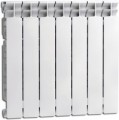Number of sections
The number of individual sections provided in the radiator of the corresponding design (see "Type"). We are talking about the delivery set: the whole radiator is assembled from separate sections, and it is not even necessary to use them all.
The number of sections in itself does not affect the performance of the product. However, this information may be useful when assembling a radiator of a certain thermal power (see "Heat output"). So, by dividing the total heat output of this model by the number of sections, you can determine the specs of one section and calculate how many of them are needed to provide the desired heat output. However, a fairly large number of modern radiators are initially sold
in one section — just so that the user can assemble the battery at his discretion. For finished products,
2 – 5 sections is considered a rather modest indicator,
6 – 10 pcs — average,
11 – 15 pcs — above average, and models for
16 – 20 sections or
more can have both horizontal and vertical layouts (in the latter case, sections placed one on top of the other, like the floors of a tower).
Heat output
The rated thermal output of the radiator is the amount of heat given off to the air in normal operation.
When choosing this parameter note that the heat output will depend on the temperature difference at the inlet and outlet to the radiator, as well as on the ambient temperature. The greater the temperature difference and the colder it is around, the more intense the heating will be. Therefore, in the specs, it is customary to indicate heat transfer for certain standard conditions. In particular, the designation according to the European standard EN-442 is very popular, which assumes heating medium temperatures of +75 °С and +65 °С at the inlet and outlet, respectively, as well as an air temperature of +20 °С. Real conditions and the actual heat output of the radiator may differ; therefore, when choosing, it is best to choose a model with a certain margin and compensate for excess power with one or another regulator. As for the actual values, in the most modest models, the heat output
does not exceed 750 W, or even
500 W, and in the largest, this figure can reach
3.5 – 4 kW or
more.
The choice for this parameter depends primarily on the size and specs of the heated space. The simplest calculation formula is as follows: at least 100 W of thermal power is required per 1 m2 of area. This formula is relevant for standard r
...esidential/office premises with ceilings of 2.5 – 3 m, without problems with thermal insulation; for more specific conditions, there are more detailed calculation methods, that can be found in special sources.Radiator height
Radiator height. The most widespread nowadays are standard height sizes:
30 cm,
40 cm,
50 cm,
60 cm and
90 cm. In addition, you can find other options (although much less often) —
20 cm,
45 cm,
55 cm,
70 cm,
75 cm and
80 cm.
Firstly, the height of the product primarily determines the size of the space required for installation. At the same time, for models placed in a niche (see "Mounting"), this dimension actually corresponds to the required depth of this niche. In other cases, it is worth taking a certain margin in height — the radiator cannot be installed close to the floor and window sill (or other similar items). And models with a bottom connection (see above) will require additional space for the pipe connection.
Secondly, this size determines heat output: all other things being equal (including the size in width), a higher radiator will have a larger working surface area and a higher heat output (this is also true for heat exchangers in convectors). Thus, modern radiators are traditionally produced not in separate models, but in series of the same type of devices that differ onl
...y in size and thermal power.Radiator width
Radiator width.
In modern models, this size can be from
10 cm or even less(in separately sold sections from sectional radiators, see "Type") to
2.5 m or more(in the largest panel products and convectors). At the same time, the design uses mainly standard widths — their list is very extensive, it mainly includes options in increments of 10 cm:
30 cm,
40 cm,
50 cm,
60 cm,
70 cm 80 cm,
90 cm,
100 cm,
110 cm,
120 cm,
130 cm,
140 cm,
150 cm etc. The actual dimensions may differ slightly from the standard, but this difference does not exceed 1 cm: for example, the category "60 cm" includes models with a width of 590 to 610 mm.
The width determines two features of the radiator at once: the size of the space required for installation, as well as heat output. In the first case, everything is quite obvious; we only note that the radiator heater should be placed close to surrounding objects so that it's ok to take a certain margin in width (and if the pipes are c
...onnected sideward, it is worth considering the space required for them). As for heat output, other things being equal, a wider device will have a larger working surface area and a higher heat output (this is also true for heat exchangers in convectors). Thus, modern radiators are traditionally produced not in separate models, but in series of the same type of devices that differ only in size and thermal output.
